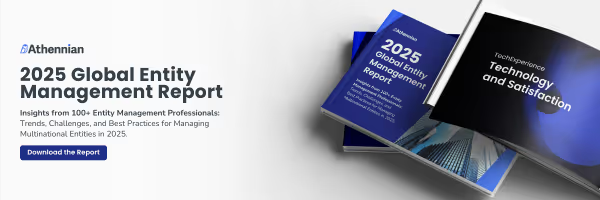Entity management used to be a back-office function: an admin-heavy process of tracking corporate records, compliance filings and governance documents. In today’s regulatory environment, however, it’s become a strategic function. Governance teams aren’t just responsible for keeping entity data in order—they’re ensuring business agility, mitigating risk and supporting high-stakes decisions.
And yet, many organizations are stuck with clunky, outdated tools.
A recent survey found that while 84% of organizations use some form of entity management software (EMS), nearly half are frustrated with their current tools. Their biggest complaints? Legacy systems are hard to use, don’t integrate with key platforms and create more work than they save. Only 21% of users report being "highly satisfied."
Meanwhile, regulatory pressures—from beneficial ownership reporting to ESG disclosures—continue to grow. Compliance isn’t getting easier, and governance teams are being asked to do more with fewer resources.
The good news? A new generation of cloud-based, AI-powered entity management solutions is emerging to solve these challenges. And when we look into the biggest trends shaping entity management in 2025, these solutions give context to what governance ops teams should consider when evaluating their software options.
Where Entity Management Software Falls Short Today
Most governance professionals know the struggle of working with outdated tools. You’re juggling spreadsheets, manually updating org charts and tracking compliance deadlines in separate systems that don’t talk to each other. It’s inefficient, risky and frustrating.
Some of the biggest pain points with legacy EMS solutions include:
- On-premise software that isn’t built for remote teams. If your entity data is locked inside a desktop application, it slows down collaboration and increases the risk of version control issues.
- Lack of integrations with e-signature, document management and ERP systems. Governance ops isn’t just about entity data—it’s tied to contracts, board decisions, tax filings and compliance workflows. When your EMS doesn’t integrate, you end up with data silos and redundant work.
- Manual, repetitive processes. Many legal professionals spend too much time on low-value tasks like tracking director changes, updating minute books and pulling reports. In fact, 87% of legal professionals say they’re bogged down by administrative work that could be automated.
- Poor user experience. Some EMS platforms feel like they were built in the early 2000s. Clunky interfaces, steep learning curves and rigid workflows make adoption a challenge, especially for non-technical users like board members and finance teams.
If any of these sound familiar, you’re not alone. Organizations are recognizing that entity management shouldn’t be this hard—and they’re looking for modern solutions that actually make governance ops more efficient.

What’s Next? The Future of Entity Management
The next wave of entity management software is more connected, automated and AI-driven than ever before, with three key trends reshaping the market:
Cloud-Based Collaboration is Now the Standard
Gone are the days of entity data being locked in on-premise systems or outdated databases. Cloud-first platforms allow legal, finance and compliance teams to work from anywhere, ensuring that entity records are always up to date. This is especially critical for multinational organizations managing entities across multiple jurisdictions.
What to look for: A solution that offers role-based access controls, real-time updates and seamless document sharing.
AI is Automating the Tedious Stuff
AI is no longer just a buzzword in legal tech. It’s actively reducing the manual burden on governance teams. AI-powered entity management software can:
- Automatically classify and tag documents to the right entity records.
- Extract key data points from filings, eliminating manual entry.
- Generate compliance alerts based on real-time regulatory updates.
- Flag discrepancies or missing information in corporate records.
For example, Athennian AI Centralize can reduce document filing time by up to 90% by automatically categorizing and linking files to the correct entity. Meanwhile, Athennian AI Initialize speeds up new entity creation by extracting key details from incorporation documents, cutting setup time from 45 minutes to under 10.
What to look for: AI that meaningfully reduces workload rather than flashy, surface-level features. Ask vendors for real-world efficiency improvements.
Governance Ops is Moving Toward an “Entity Data Hub”
Entity management doesn’t exist in a vacuum. Governance teams need tools that connect with e-signature platforms, financial systems, board governance tools and compliance trackers. That’s why modern EMS solutions are shifting toward an integrated governance hub, providing a single source of truth that syncs with your broader tech stack.
What to look for: Strong API capabilities, pre-built integrations and automated data syncing between key systems.
How to Choose the Right Entity Management Software
If you’re evaluating EMS solutions, here are five key takeaways to keep in mind:
- Choose a platform designed for governance professionals, not just IT. It should be intuitive, flexible and support real-world legal and compliance workflows.
- Prioritize cloud-based collaboration. Ensure your team can access and update entity data securely from anywhere.
- Look for deep integrations. Your EMS should connect with e-signature tools, financial software and document management systems to avoid unnecessary manual work.
- Scrutinize AI capabilities. AI should meaningfully reduce workload, whether through document automation, intelligent reminders or compliance tracking.
- Ensure scalability. Your entity management needs will grow as your organization expands, and your software should scale with you.
A Move Toward Governance Ops
Entity management isn’t just about compliance: It’s a critical piece of governance operations. Choosing the right software can free up your team’s time, reduce regulatory risk and improve decision-making at the executive level.
The best platforms in 2025 won’t just store entity data. They’ll make governance smarter, faster and more connected than ever before. If you’re evaluating EMS solutions, look for platforms that embrace cloud, AI and seamless integrations—because governance professionals deserve better than outdated, manual processes.




.svg)



.png)




-p-500.webp)
-p-500.webp)
-p-500.webp)
.webp)
